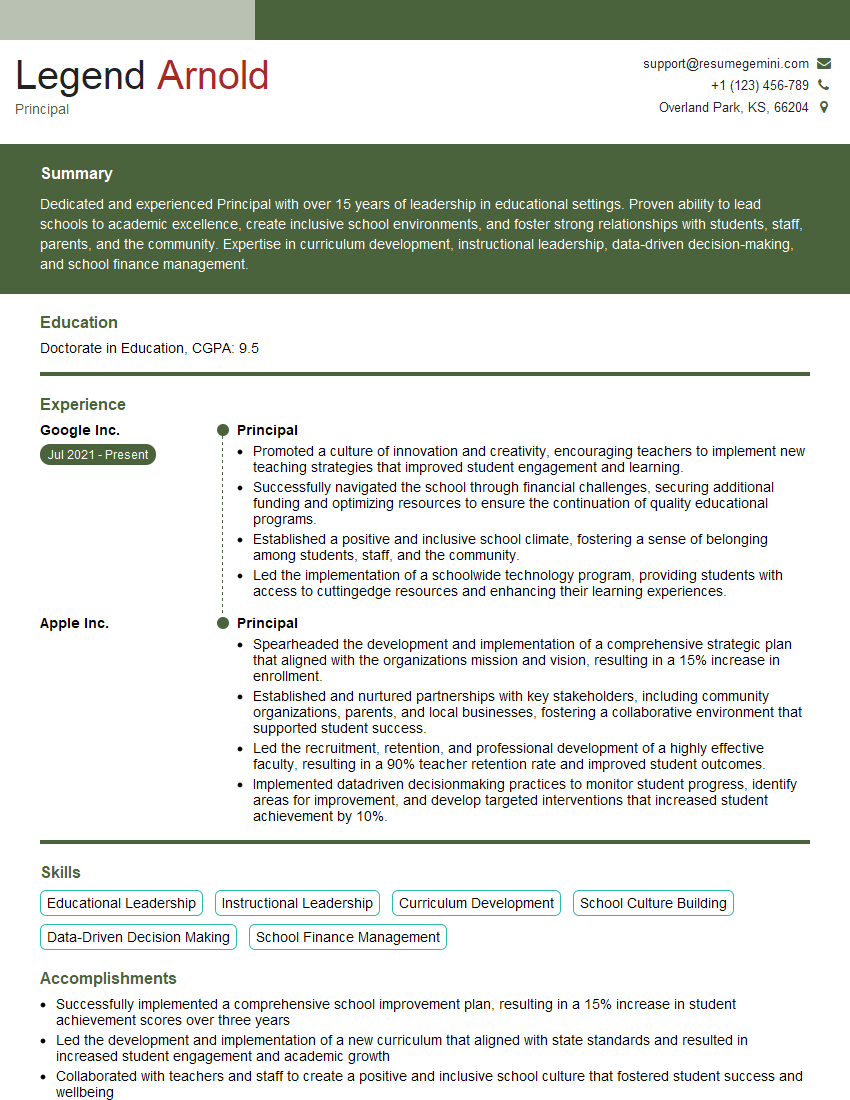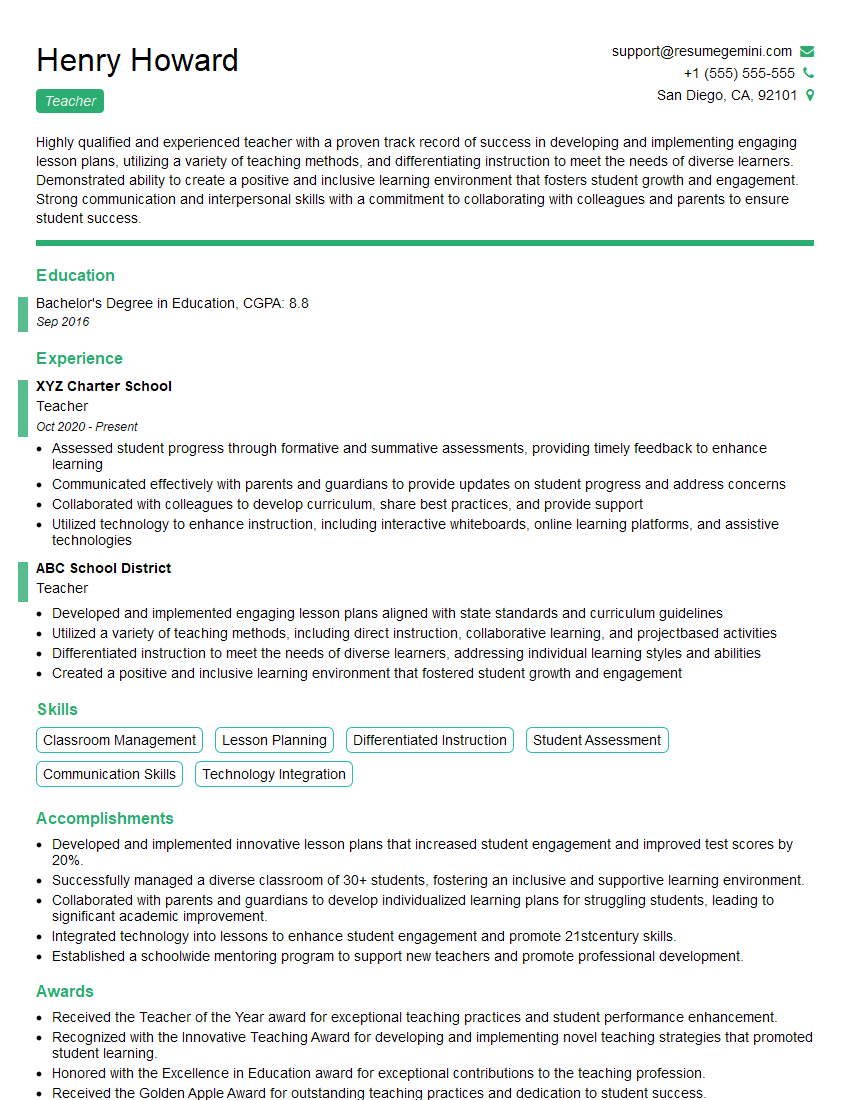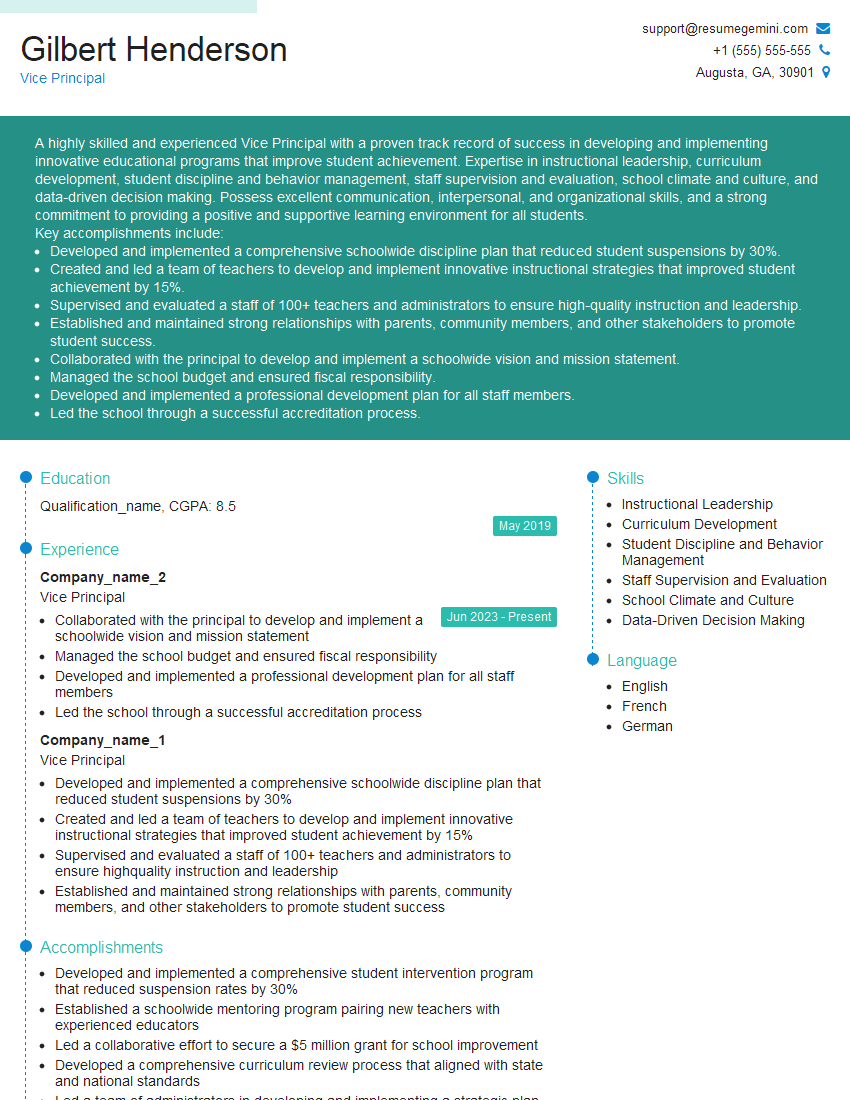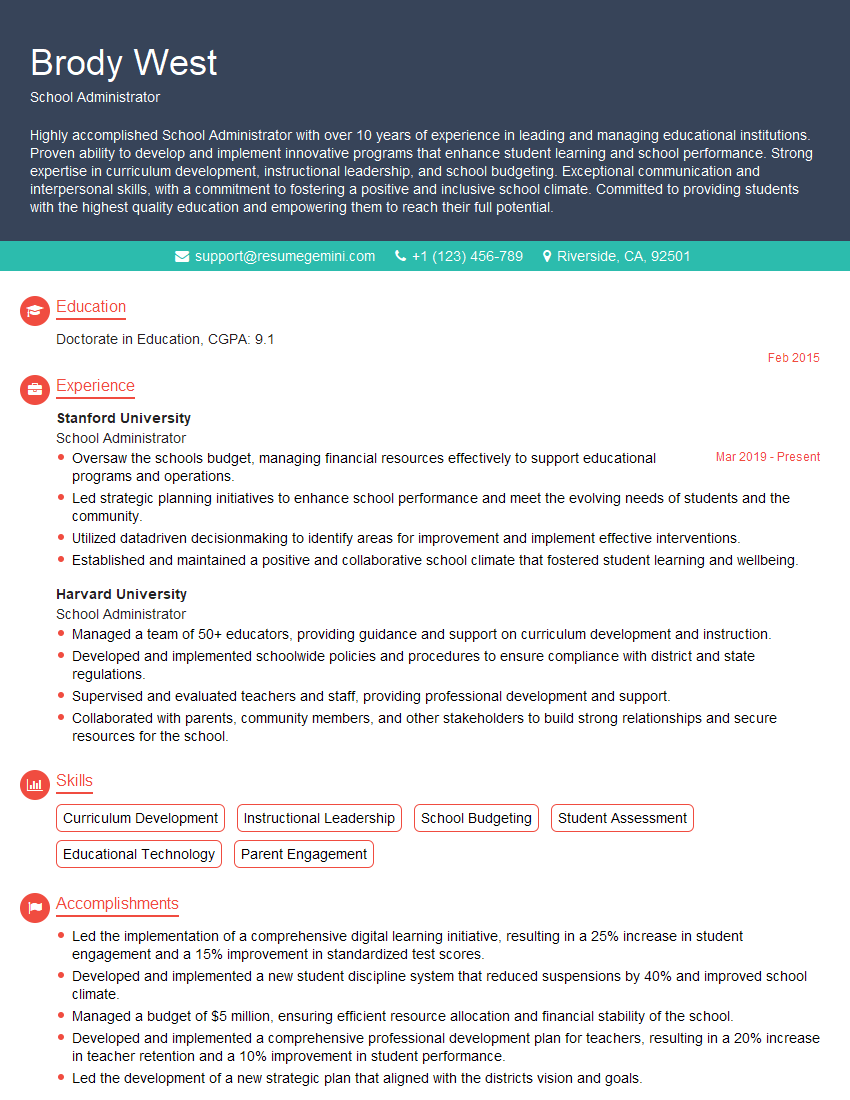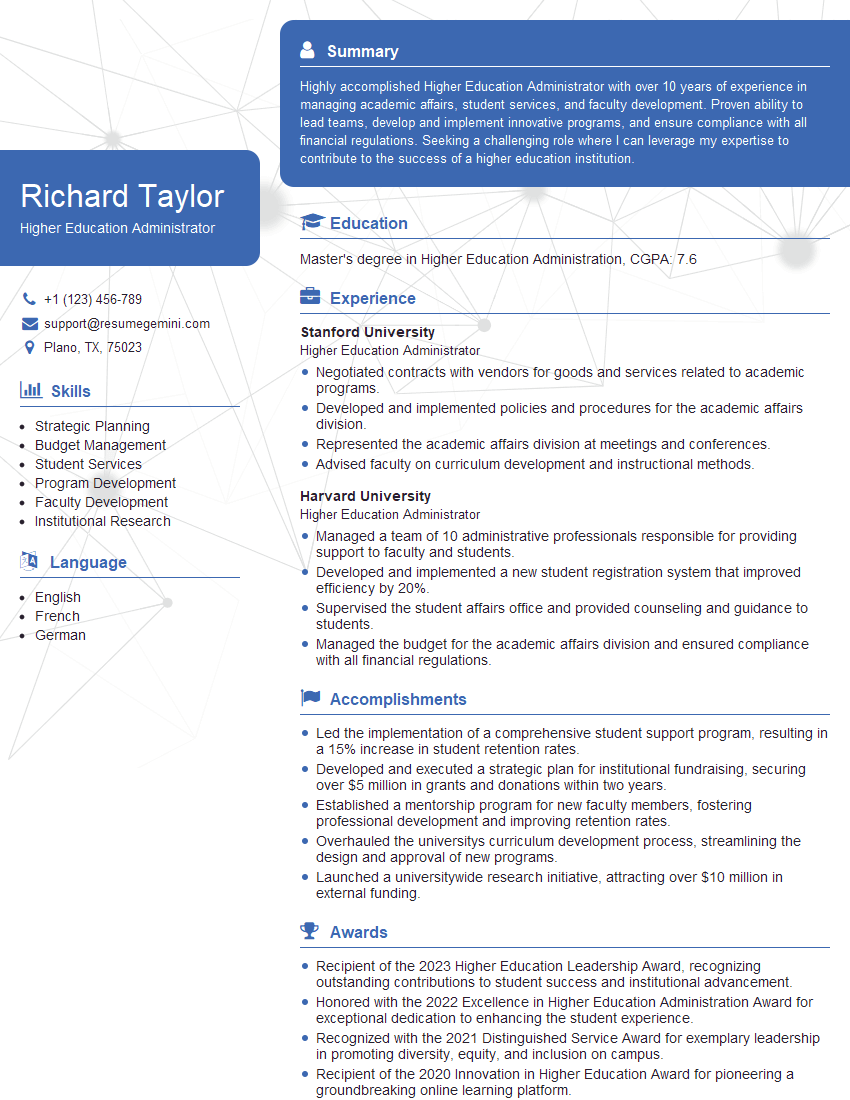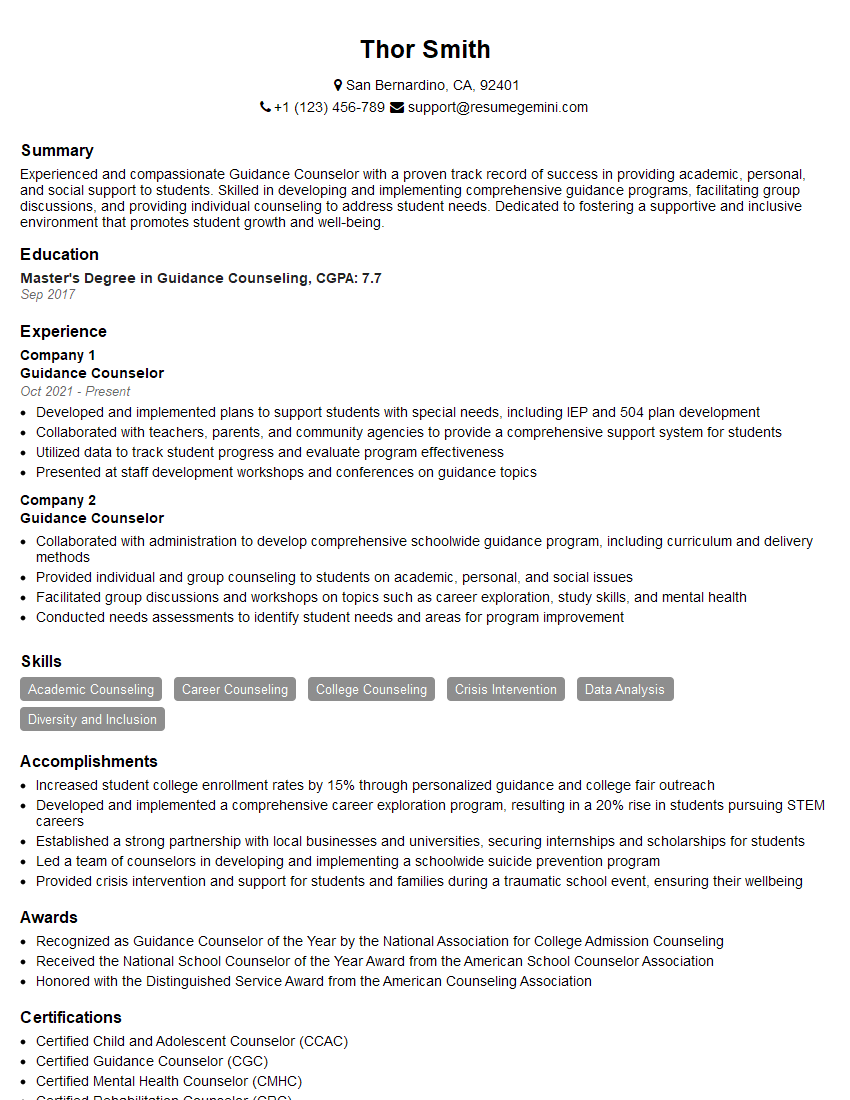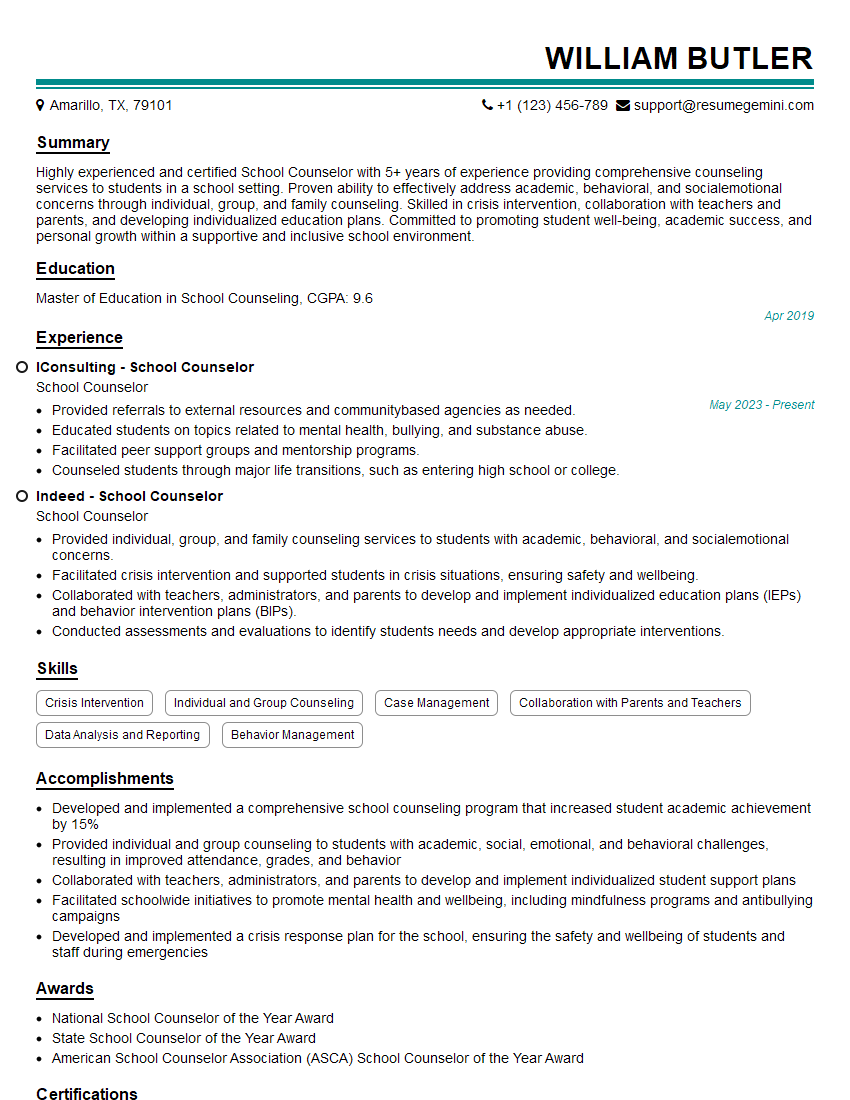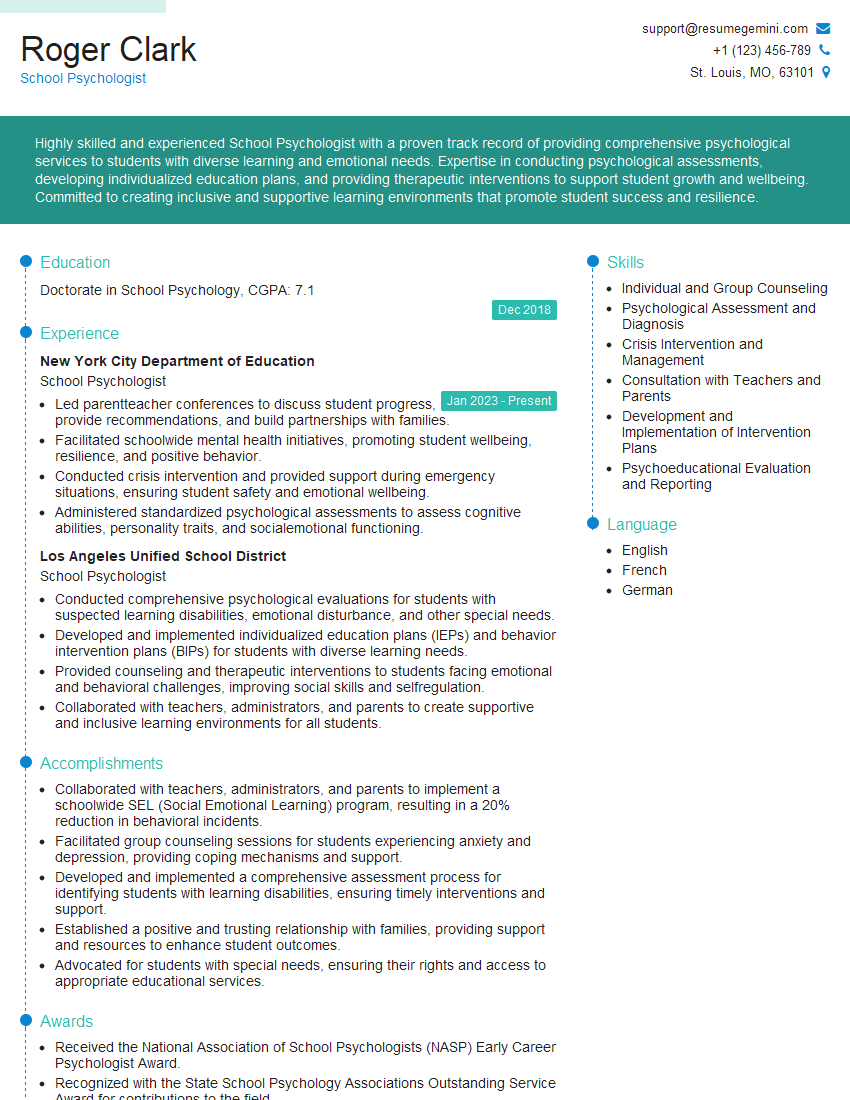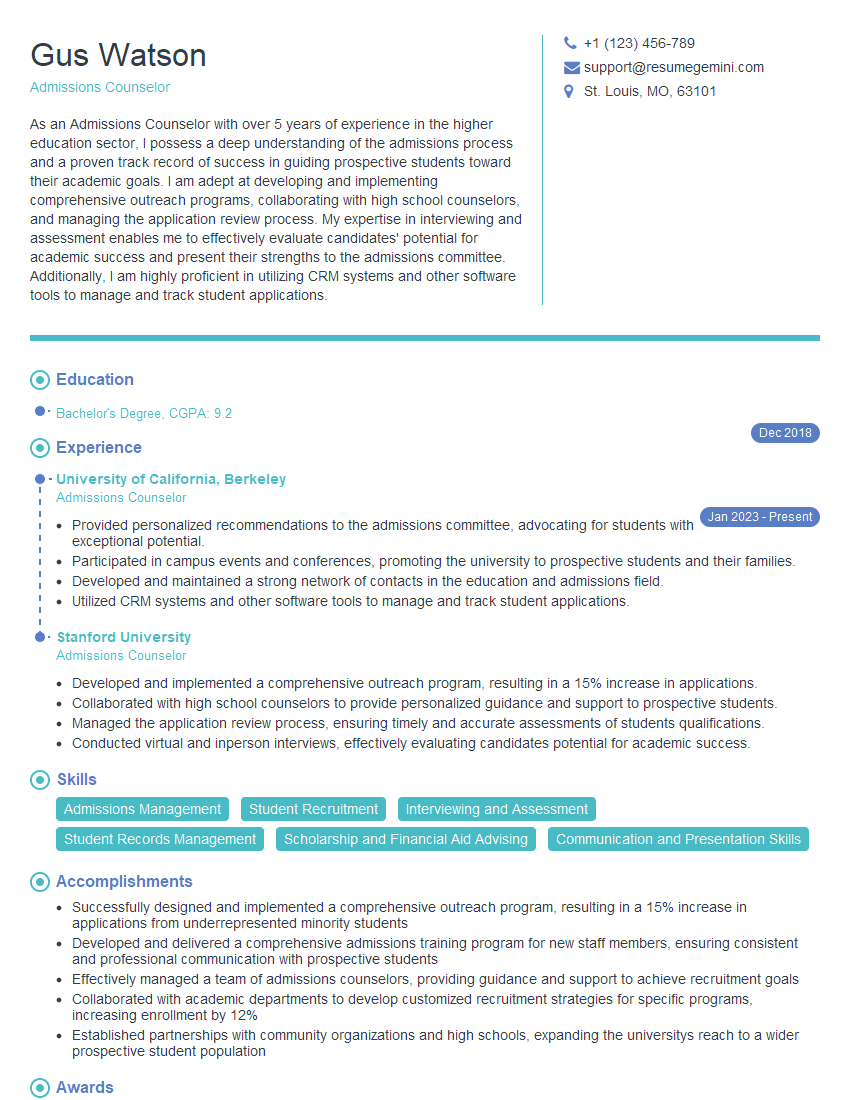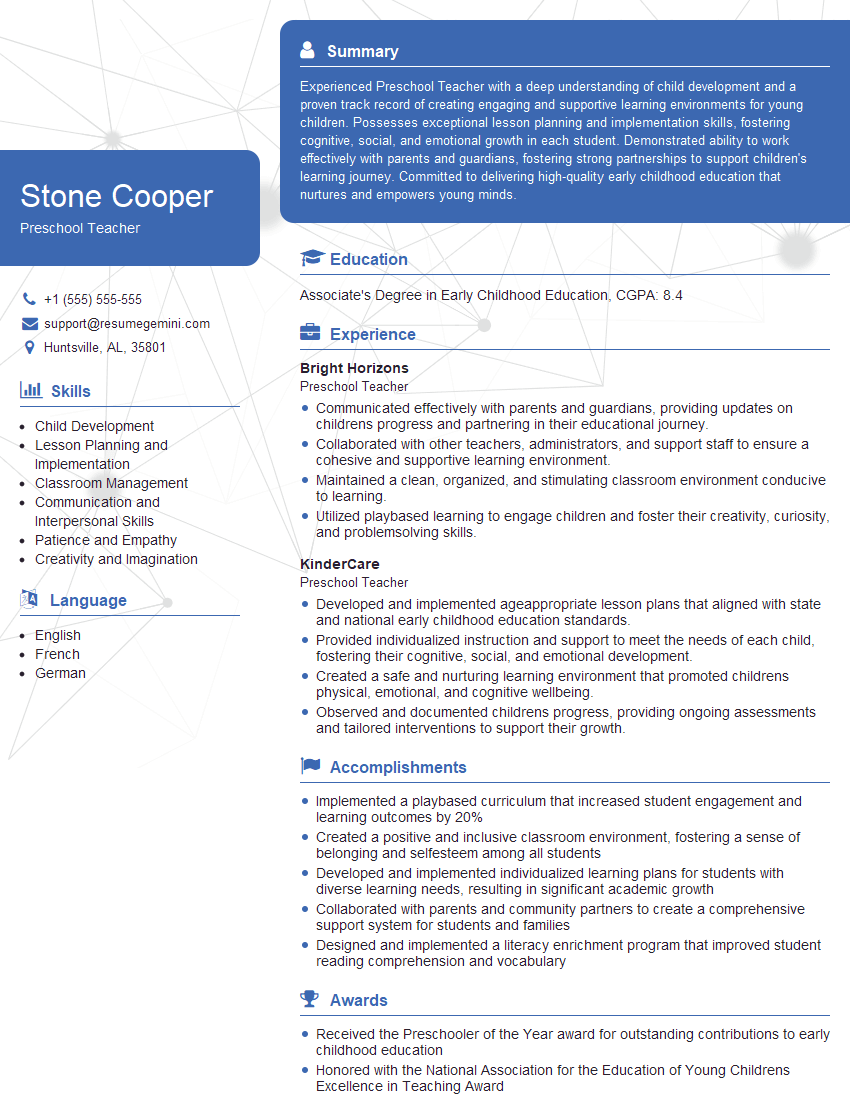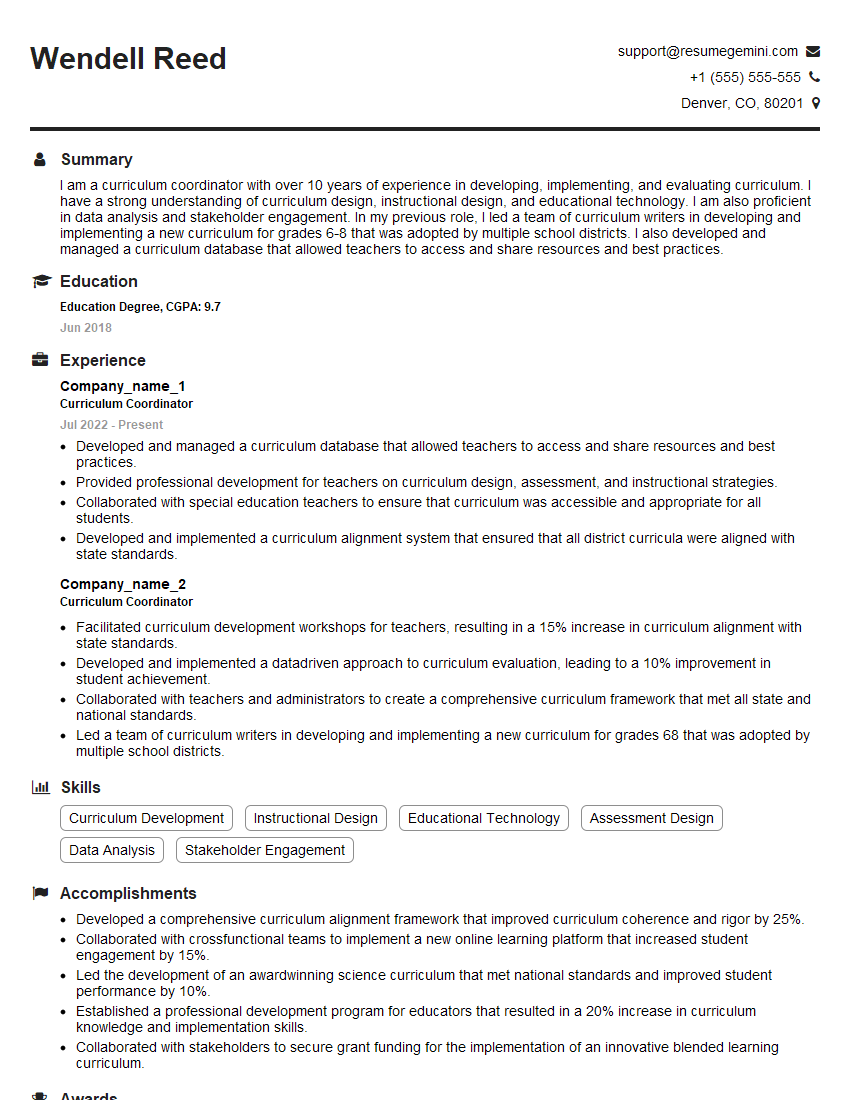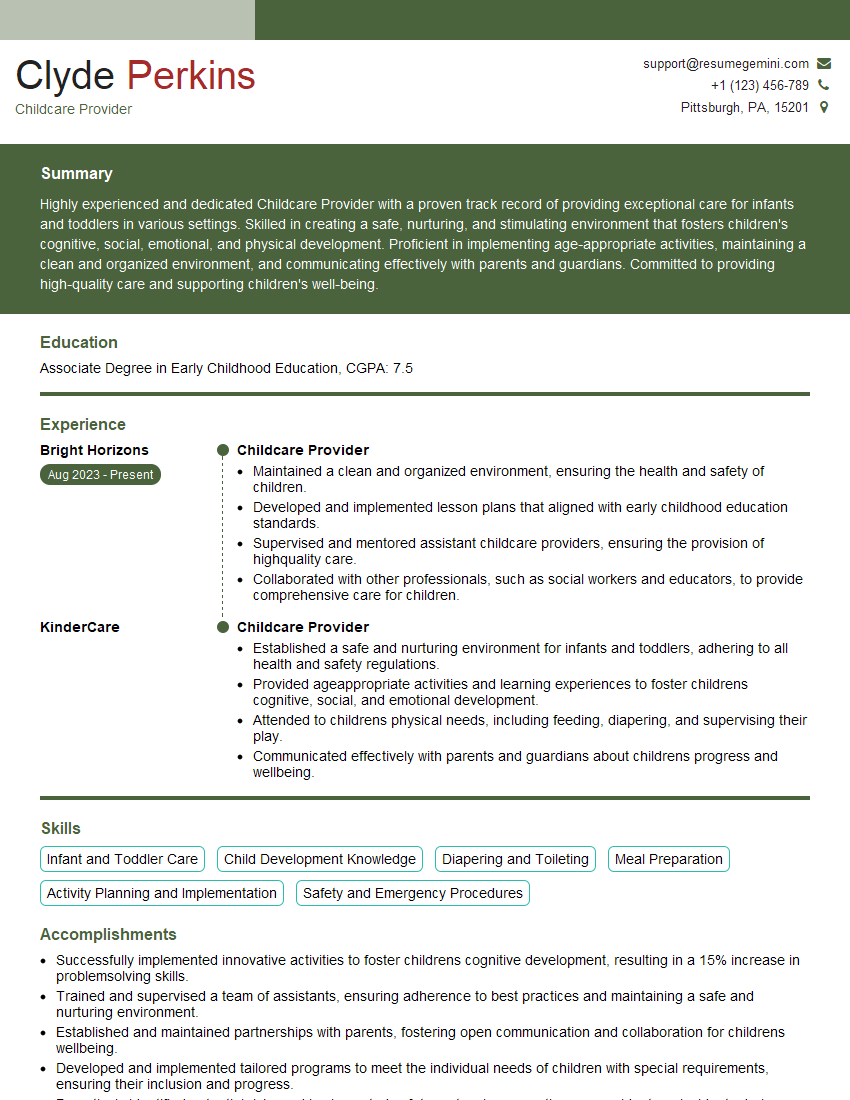Unlock your full potential by mastering the most common Collaboration with Parents, Students, and Colleagues interview questions. This blog offers a deep dive into the critical topics, ensuring you’re not only prepared to answer but to excel. With these insights, you’ll approach your interview with clarity and confidence.
Questions Asked in Collaboration with Parents, Students, and Colleagues Interview
Q 1. Describe your approach to building rapport with parents from diverse backgrounds.
Building rapport with parents from diverse backgrounds requires cultural sensitivity and a genuine desire to understand their perspectives. My approach is rooted in active listening, empathy, and a commitment to creating a safe and welcoming environment for communication. I begin by acknowledging the richness and diversity of family structures and cultural values.
- Active Listening: I ensure I fully understand their concerns and perspectives before responding. This involves not just hearing their words, but also observing their body language and considering the cultural context of their communication style. For example, some cultures might favor indirect communication, while others are more direct.
- Empathy and Respect: I make a conscious effort to understand their experiences and perspectives, even if they differ from my own. I show respect for their parenting styles and beliefs, avoiding judgment and focusing on collaboration.
- Language Access: I ensure that communication barriers are minimized by providing translation services or utilizing multilingual resources where needed. This might involve utilizing translation apps, partnering with community organizations, or seeking the help of bilingual colleagues.
- Building Trust: Trust is built over time through consistent communication, follow-through on commitments, and a willingness to be responsive to parent concerns. Regular updates, both positive and challenging, help maintain transparency and foster a stronger relationship.
For example, I once worked with a family whose primary language was Spanish. I arranged for a translator to attend our parent-teacher conferences, which allowed for a much more productive and meaningful conversation about their child’s progress. This demonstrated my commitment to their involvement and built trust between us.
Q 2. How do you effectively communicate complex information to parents with varying levels of educational attainment?
Communicating complex information effectively to parents with varying educational backgrounds requires a multi-faceted approach focused on clarity, simplicity, and accessibility. I avoid jargon and technical terms, opting instead for plain language and relatable analogies.
- Plain Language: I break down complex concepts into smaller, manageable chunks using simple language, avoiding educational jargon. For instance, instead of saying “the student is exhibiting a deficit in phonological awareness,” I might say, “Your child is having some trouble with the sounds in words.”
- Visual Aids: I use visual aids like graphs, charts, and diagrams to supplement verbal explanations. This can help parents visualize progress, understand data, and grasp complex information more easily.
- Multiple Communication Channels: I offer information in multiple formats, such as printed handouts, email updates, and school website access. This caters to different learning styles and preferences. For example, providing a video explanation in addition to a written report can benefit those who learn better visually.
- Check for Understanding: After explaining complex concepts, I always check for understanding by asking clarifying questions and encouraging parents to ask their own questions. This ensures that everyone is on the same page.
For example, when explaining a student’s standardized test scores, I use a visual representation of the data, clarifying what each aspect of the scores means in a non-technical way. Providing a handout with definitions of key terms also helps parents review the information later.
Q 3. Explain your strategy for resolving conflicts between parents and teachers.
Resolving conflicts between parents and teachers requires a collaborative and impartial approach focused on active listening, clear communication, and finding mutually agreeable solutions. My strategy involves:
- Creating a Safe Space: I facilitate a meeting in a neutral, private setting where both parties feel comfortable expressing their concerns without interruption.
- Active Listening and Empathy: I actively listen to each party’s perspective, validating their feelings and concerns without taking sides. I focus on understanding the root causes of the conflict, rather than just the surface-level symptoms.
- Collaborative Problem-Solving: I encourage open dialogue and brainstorming to identify potential solutions that meet the needs of both parties. This process involves exploring alternative perspectives and seeking common ground.
- Documenting Agreements: Once a solution is agreed upon, I document it in writing for clarity and accountability. This document outlines the responsibilities of each party and the steps involved in implementing the agreement.
- Follow-up and Monitoring: I schedule follow-up meetings to monitor the effectiveness of the agreed-upon solution and address any new concerns that may arise.
For instance, if a parent disagrees with a teacher’s assessment of their child’s performance, I would facilitate a meeting where both parties can present their perspectives. Together, we might explore alternative assessment methods, agree on a plan for improved communication, and set goals for the student’s future progress. The written agreement ensures everyone is clear on expectations and steps forward.
Q 4. How do you involve parents in their child’s education?
Involving parents in their child’s education is crucial for student success. My approach incorporates various strategies designed to accommodate diverse family circumstances and preferences.
- Regular Communication: I provide regular updates on student progress through various channels (email, newsletters, parent-teacher conferences, etc.). I tailor communication to suit individual family needs and preferences.
- Parent-Teacher Conferences: I conduct regular parent-teacher conferences to discuss student progress, address concerns, and collaboratively plan for future success. I actively solicit parental input and perspectives.
- Volunteer Opportunities: I create opportunities for parent involvement in the classroom and school activities. This allows parents to contribute their skills and expertise and strengthens the school-home connection.
- Workshops and Training Sessions: I offer workshops and training sessions on topics related to education, parenting, and student well-being. These opportunities enhance parental knowledge and skills.
- Technology Integration: I use technology platforms like learning management systems (LMS) to share resources, track progress, and facilitate communication between home and school. This fosters more convenient access to educational materials.
For example, I developed a parent-led reading program where parents volunteered to read with students once a week during school hours. This improved literacy skills, fostered family involvement, and created a supportive school community.
Q 5. How do you facilitate open communication and collaboration amongst teaching staff?
Facilitating open communication and collaboration among teaching staff is essential for creating a cohesive and supportive learning environment. My strategy focuses on building trust, establishing clear communication channels, and fostering a culture of shared responsibility.
- Regular Team Meetings: I organize regular team meetings where teachers can share information, discuss student progress, collaborate on lesson planning, and address any concerns. I foster a positive and supportive environment during these meetings.
- Open Door Policy: I maintain an open-door policy, encouraging teachers to share their ideas, concerns, and challenges openly and without fear of judgment. I am readily available for consultations and support.
- Collaborative Planning: I encourage collaborative lesson planning and team teaching to enhance efficiency and creativity. This creates opportunities for shared expertise and mutual learning.
- Professional Development: I actively participate in professional development activities to enhance my own skills and provide opportunities for teachers to improve their teaching practices and collaboration skills.
- Shared Resources and Technology: I provide access to shared resources, technology, and tools to streamline collaboration and communication. This includes using collaborative platforms for document sharing, project management, and communication.
For example, our team uses a shared online calendar to coordinate events and meetings. We also have a collaborative workspace where we share lesson plans, resources, and assessment materials. This creates a centralized hub for all our team’s work and fosters a collaborative environment.
Q 6. Describe a time you successfully mediated a disagreement between students.
I once mediated a disagreement between two students who were involved in a conflict over a shared project. Both students felt their contributions were undervalued, leading to tension and frustration.
My approach focused on active listening and empathetic understanding. I first allowed each student to explain their perspective without interruption, ensuring they felt heard and validated. I then helped them identify the root of the conflict – a misunderstanding regarding roles and responsibilities within the project. I facilitated a collaborative discussion where they redefined roles and tasks, ensuring clear expectations and responsibilities for each student.
We worked together to create a revised project timeline and outlined clear communication strategies to prevent future misunderstandings. Finally, I encouraged them to focus on collaboration and mutual support to complete the project successfully. The result was a much-improved project, enhanced communication skills for both students, and a valuable lesson in conflict resolution.
Q 7. How do you adapt your communication style to meet the needs of different students?
Adapting my communication style to meet the needs of different students is paramount to effective teaching. This requires a deep understanding of individual learning styles, emotional needs, and cultural backgrounds.
- Differentiated Instruction: I employ differentiated instruction techniques, adjusting the content, process, product, or learning environment to meet the diverse needs of my students. This involves understanding various learning styles (visual, auditory, kinesthetic) and tailoring my teaching methods accordingly.
- Building Relationships: I prioritize building strong relationships with each student, learning about their interests, strengths, and challenges. This personalized approach creates a sense of trust and support.
- Clear and Concise Language: I use clear and concise language, avoiding jargon and adapting my vocabulary to match the student’s comprehension level. I ensure that instructions are easily understood and accessible to all learners.
- Non-verbal Communication: I pay close attention to non-verbal cues, such as body language and facial expressions, to understand a student’s emotional state and adapt my communication style accordingly. I maintain a positive and supportive demeanor to build confidence and trust.
- Multiple Communication Channels: I use a variety of communication channels to share information with students, including verbal instructions, written assignments, visual aids, and technology. This ensures that information is accessible to students with different learning styles and preferences.
For example, for a student who struggles with reading comprehension, I might provide audio recordings of assignments or use visual aids to support their understanding. For a student who is more kinesthetic, I would incorporate hands-on activities and group projects into my lessons.
Q 8. How do you create a positive and inclusive classroom environment that fosters student collaboration?
Creating a positive and inclusive classroom environment that fosters student collaboration is paramount to successful learning. It’s about building a sense of community where every student feels safe, respected, and valued for their unique contributions.
- Establishing clear expectations: From day one, I clearly communicate expectations regarding respect, active listening, and collaborative problem-solving. This includes establishing classroom norms collaboratively with students, empowering them to take ownership of their learning environment.
- Diverse learning activities: I incorporate a variety of collaborative activities, such as think-pair-share, jigsaw activities, and group projects, to cater to different learning styles and strengths. For instance, a jigsaw activity allows students to become experts in a specific part of a topic and then teach their peers, fostering peer-to-peer learning and collaboration.
- Providing opportunities for student voice: I actively solicit student feedback through regular check-ins, surveys, and class discussions. This ensures that the learning environment is responsive to their needs and preferences. For example, I might ask, “What worked well in today’s group activity? What could we improve?”
- Promoting positive interdependence: I design activities that require students to rely on each other to achieve a common goal. This promotes a sense of shared responsibility and mutual support. For example, in a group project, each student might be responsible for a specific aspect, but the final product requires the integration of all contributions.
- Celebrating successes: Recognizing and celebrating both individual and group achievements boosts morale and reinforces positive collaboration. This could be through verbal praise, certificates, or showcasing student work.
Q 9. How do you incorporate parent feedback into your teaching practices?
Parent feedback is invaluable in understanding the whole child and tailoring my teaching approach to meet their individual needs. I actively seek parent input through various channels to create a strong home-school connection.
- Parent-teacher conferences: These are crucial for open dialogue and two-way communication. I actively listen to parent concerns, share observations about the student’s progress, and collaboratively develop strategies to support their learning.
- Surveys and questionnaires: I regularly send out short surveys or questionnaires to gauge parent opinions on curriculum, teaching methods, and classroom environment. This allows me to gather data and make informed adjustments.
- Informal communication: I encourage parents to contact me anytime with questions or concerns. This could be through email, phone calls, or informal notes. I maintain an open-door policy.
- Classroom newsletters or blogs: These provide regular updates on classroom activities, curriculum, and upcoming events, keeping parents informed and involved.
- Parent volunteers: Inviting parents to volunteer in the classroom offers them a firsthand look at classroom dynamics and allows for meaningful interaction.
For instance, a parent’s feedback about a student’s struggle with time management led me to incorporate specific time management strategies into my lessons and provide individual support.
Q 10. How do you use technology to enhance collaboration with parents and students?
Technology plays a significant role in enhancing communication and collaboration among parents, students, and myself. I leverage various platforms to streamline information sharing and create a more connected learning community.
- Learning Management Systems (LMS): Platforms like Google Classroom or Canvas allow me to post assignments, grades, announcements, and resources, ensuring parents have easy access to their child’s academic progress. I also use them for communicating directly with students and parents.
- Communication apps: Tools like ClassDojo or Remind allow for quick updates, reminders, and announcements. These apps minimize email overload and reach parents through their preferred communication channel.
- Video conferencing: Tools like Zoom or Google Meet facilitate virtual parent-teacher conferences, allowing for flexibility and convenience.
- Digital portfolios: Students can showcase their work through digital portfolios, allowing parents to track their progress and celebrate their achievements. This also creates a platform for reflection and self-assessment.
For example, using Google Classroom to post assignments and receive submissions has significantly reduced paperwork and improved transparency.
Q 11. Describe your process for identifying and addressing student learning challenges through collaboration.
Identifying and addressing student learning challenges requires a collaborative approach involving the student, parents, and myself. I employ a multi-faceted strategy to ensure comprehensive support.
- Ongoing assessment: I use a variety of assessment methods, including formative and summative assessments, to monitor student progress and identify areas of difficulty. This might involve quizzes, projects, classwork, and observations.
- Data analysis: I analyze assessment data to identify patterns and trends in student performance. This helps me pinpoint specific learning challenges that require attention.
- Student-led conferences: These conferences empower students to take ownership of their learning and articulate their strengths and challenges. It allows for a more holistic understanding of their learning journey.
- Parent communication: I communicate findings with parents promptly, explaining the challenges and collaboratively developing strategies for support. This might include suggestions for home-based interventions or seeking additional support from specialists.
- Collaboration with specialists: If necessary, I collaborate with school counselors, special education teachers, or other specialists to develop individualized education plans (IEPs) or support programs for students with specific needs.
For example, through consistent monitoring and collaboration with a student’s parents, we identified a reading difficulty. We then implemented targeted interventions, such as utilizing specific reading programs and strategies, leading to significant improvement in the student’s reading skills.
Q 12. How do you ensure that all stakeholders (parents, students, teachers) are informed and involved in decision-making processes?
Ensuring all stakeholders are informed and involved in decision-making is crucial for building a strong and collaborative school community. I utilize various strategies to foster inclusivity and shared responsibility.
- Open communication: I prioritize open and transparent communication with all stakeholders. This involves regularly sharing information, soliciting feedback, and actively listening to diverse perspectives.
- Parent-teacher organizations (PTOs): I actively participate in PTO meetings and events to foster collaboration and shared decision-making on school-wide initiatives.
- Student councils or representative bodies: Involving students in decision-making through student councils provides opportunities for their voices to be heard and valued.
- Surveys and feedback mechanisms: I regularly solicit feedback from parents, students, and colleagues through surveys and feedback forms to gauge satisfaction and identify areas for improvement.
- Collaborative problem-solving: When facing challenges, I work collaboratively with parents, students, and colleagues to identify solutions, ensuring everyone feels heard and valued.
For instance, when considering a change to the school curriculum, I would involve parents through surveys and discussions, gather student feedback through focus groups, and discuss the proposal with colleagues before making a final decision.
Q 13. What strategies do you employ to build strong relationships with colleagues?
Building strong relationships with colleagues is essential for creating a supportive and collaborative work environment. I believe in fostering mutual respect, open communication, and shared learning.
- Regular communication: I maintain regular contact with colleagues, sharing ideas, best practices, and resources. This might involve informal chats, team meetings, or collaborative lesson planning sessions.
- Professional development: I actively participate in professional development opportunities, sharing knowledge and collaborating with colleagues to enhance our teaching practices.
- Mentorship and peer coaching: I actively engage in mentorship and peer coaching activities, sharing expertise and supporting colleagues in their professional growth.
- Collaborative planning: I engage in collaborative lesson planning, sharing ideas and resources to create engaging and effective learning experiences for students.
- Mutual support and respect: I foster a culture of mutual support and respect within the team, recognizing the importance of teamwork and shared responsibility.
For example, collaborating with a colleague on a challenging project not only yielded a better result, but also strengthened our professional bond and fostered mutual respect and understanding.
Q 14. How do you manage competing priorities when collaborating with multiple stakeholders?
Managing competing priorities when collaborating with multiple stakeholders requires effective organizational skills, clear communication, and a prioritization framework.
- Prioritization matrix: I use a prioritization matrix (e.g., Eisenhower Matrix – urgent/important) to identify and address the most pressing issues first, ensuring that urgent matters are addressed without neglecting important long-term goals.
- Time management techniques: I employ time management techniques, such as time blocking and task delegation, to allocate sufficient time for each task and avoid feeling overwhelmed.
- Clear communication and expectations: I maintain clear and consistent communication with all stakeholders, outlining expectations and deadlines to ensure everyone is aligned.
- Regular check-ins: I schedule regular check-in meetings with key stakeholders to monitor progress, address any challenges, and adjust plans as needed.
- Flexibility and adaptability: I remain flexible and adaptable, recognizing that priorities can change and that adjustments are sometimes necessary.
For example, if a student is facing a significant academic challenge, I prioritize addressing this issue while still communicating updates to parents and colleagues regarding other responsibilities.
Q 15. Explain your approach to conflict resolution in a collaborative setting.
My approach to conflict resolution is rooted in collaborative problem-solving, focusing on understanding perspectives before seeking solutions. I employ a structured approach, starting with active listening to ensure everyone feels heard. This includes paraphrasing to confirm understanding and validating emotions, even if I don’t agree with the underlying sentiment. Next, I guide the discussion towards identifying the root cause of the conflict, not just the symptoms. Once the root cause is understood, we brainstorm solutions collaboratively, ensuring each party feels ownership in the process. Finally, we agree upon a clear action plan with defined roles and timelines, and regularly check in to monitor progress and make adjustments as needed. Think of it like building a bridge – we need to understand both sides of the river (perspectives) before designing a structure (solution) that connects them safely and effectively.
For example, if a student and parent disagree on a grade, I wouldn’t immediately mediate the disagreement. Instead, I would first listen to both perspectives, clarify what the concerns are, and understand the expectations. Then, we would work together to create a solution, perhaps by reviewing the student’s work, discussing areas for improvement, and setting clear goals for future assignments.
Career Expert Tips:
- Ace those interviews! Prepare effectively by reviewing the Top 50 Most Common Interview Questions on ResumeGemini.
- Navigate your job search with confidence! Explore a wide range of Career Tips on ResumeGemini. Learn about common challenges and recommendations to overcome them.
- Craft the perfect resume! Master the Art of Resume Writing with ResumeGemini’s guide. Showcase your unique qualifications and achievements effectively.
- Don’t miss out on holiday savings! Build your dream resume with ResumeGemini’s ATS optimized templates.
Q 16. Describe a time you had to navigate a difficult situation involving parent concerns.
I once faced a difficult situation with a parent who was deeply concerned about their child’s social interaction in class. The parent felt their child was being isolated and bullied, while classroom observations and peer reports didn’t fully support this. Instead of dismissing their concerns, I initiated a series of meetings where I actively listened to the parent’s perspective, validated their feelings, and shared my observations based on classroom dynamics. We then collaboratively devised a plan: I increased my observation of their child during recess and lunch, implemented strategies to encourage inclusion through specific group activities, and set up regular check-ins with the student. I also suggested the parent and I schedule weekly phone calls to track progress. The situation improved gradually, and the parent eventually felt reassured by our collaborative approach and the positive changes in their child’s experiences. The key was open communication, demonstrating empathy, and working together to find a solution that addressed both the parent’s concerns and the child’s well-being.
Q 17. How do you foster a culture of collaboration within your team?
Fostering a collaborative team culture requires intentional effort. I begin by clearly defining shared goals and expectations, ensuring everyone understands their role in achieving them. Regular team meetings are crucial, offering a forum for open communication, brainstorming, and problem-solving. I actively encourage open dialogue, respecting differing viewpoints and valuing diverse contributions. We use collaborative tools like shared online calendars, project management software, and regular feedback sessions to keep everyone informed and engaged. I also prioritize professional development opportunities that focus on teamwork and communication skills. Recognizing and celebrating team achievements reinforces the importance of collaboration and builds morale. Think of it like a sports team – everyone needs to know their position, communicate effectively, and work together towards a common victory.
Q 18. How do you solicit and utilize constructive feedback from colleagues and parents?
I solicit constructive feedback using various methods, including formal surveys, informal check-ins, and structured feedback sessions. For colleagues, I might use peer observation followed by a debriefing session. For parents, I might send out regular surveys about their experiences and hold parent-teacher conferences focused on specific areas for improvement. I utilize this feedback by analyzing the trends and identifying areas for professional growth. This might lead to changes in teaching methods, curriculum design, or communication strategies. I aim for a continuous improvement cycle where feedback is actively sought, thoughtfully analyzed, and concretely applied to enhance my practice and the overall effectiveness of the collaborative environment. For instance, if parent feedback consistently points to a need for clearer communication about assignments, I might implement a new system of online announcements and parent-student communication tools.
Q 19. How do you ensure that all students feel heard and respected in collaborative activities?
Ensuring all students feel heard and respected in collaborative activities requires a multi-faceted approach. I begin by establishing clear guidelines for respectful interaction and collaboration. This includes teaching active listening skills, encouraging empathy, and promoting inclusive language. I use diverse group structures, ensuring that quieter or less dominant students have opportunities to contribute. I also utilize various communication methods, including written assignments, visual aids, and verbal discussions, to accommodate diverse learning styles and preferences. I regularly monitor group dynamics, intervening when necessary to facilitate balanced participation and address any conflicts respectfully. For example, I might use small group activities with clearly defined roles, making sure each student has a specific task and opportunity to share their work and ideas with the larger group.
Q 20. How do you promote shared responsibility amongst parents and teachers for student success?
Promoting shared responsibility for student success involves establishing a strong partnership between parents and teachers. Open communication is paramount; regular updates through newsletters, email, or parent-teacher conferences keep everyone informed about student progress. We need to establish shared goals, collaboratively setting realistic expectations for the student. I actively encourage parents’ involvement in their child’s learning, through volunteering, assisting with homework, and attending school events. This creates a sense of community and shared ownership of the educational journey. A system of regular feedback loops keeps everyone aligned and provides opportunities for adjustments. Think of it like a relay race – each participant (parent, teacher, student) needs to work together to ensure successful completion of the race (student’s success).
Q 21. How do you balance individual student needs with the needs of the larger class when collaborating?
Balancing individual student needs with the larger class’s needs involves careful planning and differentiation. I begin by assessing individual student needs, identifying any learning gaps or challenges. Then I design lessons that address the common curriculum goals, but with varied levels of support and challenge. This might include providing different worksheets, offering small group instruction, or assigning differentiated tasks within a collaborative activity. I utilize flexible grouping strategies that allow for both whole-class instruction and small group work tailored to specific needs. Regular monitoring of individual progress helps me adjust my approach as needed and ensures that all students are making meaningful progress, whether they are working independently, in pairs, or within a larger group. For instance, while the whole class is working on a science experiment, students requiring additional support might work with me individually on a simplified version of the experiment before joining the main group.
Q 22. Describe a time you successfully collaborated with a colleague to achieve a common goal.
Collaboration is the cornerstone of effective education. One instance where I successfully collaborated with a colleague involved developing a new, interdisciplinary unit on climate change for our 7th-grade students. My colleague, a science teacher, possessed extensive knowledge of the environmental impacts, while my expertise lay in integrating social studies perspectives. We began by outlining shared learning objectives, deciding on a project-based learning approach culminating in student-led presentations. We then divided tasks, with me focusing on the social and economic implications of climate change and my colleague on the scientific aspects. Regular meetings allowed us to share resources, refine activities, and address any emerging challenges. We used Google Docs to collaboratively create lesson plans, assessments, and rubrics, ensuring transparency and efficient revision. The result was a highly engaging unit, praised by both students and administrators, exceeding our initial expectations and demonstrating the power of synergistic collaboration.
Q 23. How do you utilize data to inform your collaboration strategies?
Data plays a crucial role in informing my collaboration strategies. For example, student performance data on formative assessments can highlight areas where students struggle, indicating the need for targeted interventions. By analyzing this data with colleagues, we can identify common misconceptions or gaps in our teaching approaches. We might discover that students are struggling with a specific concept in both science and math classes, suggesting a need for a cross-curricular, collaborative teaching approach. Similarly, we can use data on student attendance and engagement in extracurricular activities to improve communication with parents and design interventions that support students’ overall well-being. This data-driven approach helps shift our collaboration from general observations to specific, targeted efforts for improved student outcomes.
Q 24. How do you ensure that all communication with parents is clear, concise, and professional?
Clear, concise, and professional communication with parents is essential. I prioritize using a consistent format for all communication, typically starting with a personalized greeting followed by a brief, factual summary of the situation. I avoid educational jargon and utilize plain language. I always provide specific examples and evidence to support my observations or concerns. For instance, instead of saying ‘Sarah is struggling in math,’ I would say, ‘Sarah’s recent math tests show difficulty understanding fractions, specifically when applying them to real-world problems.’ I also actively solicit feedback, encouraging questions and dialogue. I use multiple communication channels—e.g., emails, phone calls, school messaging platforms—to ensure messages reach parents effectively. Finally, I always maintain a respectful and professional tone, regardless of the context.
Q 25. Describe your experience using different communication platforms for collaboration.
I’m proficient in using various communication platforms for collaboration. Email remains a cornerstone for formal communication and sharing documents. For real-time discussions and quick information exchange, platforms like Slack or Microsoft Teams are invaluable. These platforms allow for immediate feedback and efficient problem-solving. For collaborative document creation, Google Docs and shared online drives are essential. For larger projects involving multiple stakeholders, project management software such as Asana or Trello can be very helpful for task assignment, progress tracking, and efficient workflow management. The choice of platform depends on the specific needs and the size of the collaborative group.
Q 26. How do you maintain confidentiality when collaborating with parents and students?
Maintaining confidentiality is paramount. I adhere strictly to school policies and legal requirements regarding student and parent information. I never discuss student or parent information in public areas or with unauthorized individuals. All electronic communication is password-protected and stored securely. When discussing students with colleagues, I only share information relevant to the collaborative effort, using pseudonyms whenever possible. Parent consent is always obtained before sharing sensitive information with third parties. Open communication with parents about how their information is protected builds trust and reinforces the importance of confidentiality.
Q 27. How do you address ethical dilemmas that may arise during collaboration?
Ethical dilemmas can arise in collaborative settings. For example, a conflict might occur between a parent’s desire for a particular learning approach and the school’s established curriculum. In such cases, I approach the situation by actively listening to all perspectives, emphasizing transparency and fairness. I would consult school policies and seek guidance from administrators or colleagues with relevant expertise. I would also ensure that all decisions are made in the best interest of the student, emphasizing the importance of open communication, collaboration, and shared decision-making. Documenting all discussions and decisions helps maintain transparency and accountability.
Q 28. How do you measure the effectiveness of your collaboration efforts?
Measuring the effectiveness of collaboration efforts requires a multifaceted approach. Student learning outcomes, as measured by assessments, are a key indicator. We also gather feedback from students, parents, and colleagues through surveys, focus groups, or informal discussions. Improvements in student engagement, as observed in class participation and project completion, are also important metrics. Finally, we analyze changes in communication patterns and collaboration processes to identify areas of strength and weakness. By regularly evaluating these different aspects, we can refine our collaborative practices, ensuring that our efforts are consistently effective and benefit all stakeholders.
Key Topics to Learn for Collaboration with Parents, Students, and Colleagues Interview
- Effective Communication Strategies: Understanding diverse communication styles and adapting your approach to build rapport with parents, students, and colleagues from varied backgrounds.
- Building Trust and Rapport: Practical application of active listening, empathy, and conflict resolution skills to foster positive relationships.
- Conflict Resolution and Negotiation: Techniques for navigating disagreements and finding mutually agreeable solutions in challenging situations involving parents, students, or colleagues.
- Collaborative Problem-Solving: Utilizing teamwork and brainstorming methodologies to address complex issues and achieve shared goals.
- Parent-Teacher/Advisor Communication: Establishing efficient channels and strategies for keeping parents/guardians informed and involved in their child’s educational journey, addressing concerns promptly and professionally.
- Student-Centered Collaboration: Fostering a collaborative learning environment where students feel empowered to participate actively and contribute meaningfully to their learning and the classroom community.
- Teamwork and Collaboration with Colleagues: Effectively contributing to a team, sharing responsibilities, and maintaining productive working relationships with colleagues to achieve common goals.
- Utilizing Technology for Collaboration: Leveraging various communication platforms and tools to enhance collaboration and communication with parents, students, and colleagues (e.g., email, learning management systems, video conferencing).
- Ethical Considerations in Collaboration: Understanding and upholding confidentiality, maintaining professional boundaries, and navigating sensitive situations ethically.
Next Steps
Mastering collaboration with parents, students, and colleagues is crucial for career advancement in many fields. It demonstrates essential soft skills highly valued by employers. To significantly boost your job prospects, create an ATS-friendly resume that highlights your relevant experience and skills. ResumeGemini is a trusted resource to help you build a professional and impactful resume. We provide examples of resumes tailored to showcase expertise in collaboration with parents, students, and colleagues, helping you present your qualifications effectively to potential employers.
Explore more articles
Users Rating of Our Blogs
Share Your Experience
We value your feedback! Please rate our content and share your thoughts (optional).
What Readers Say About Our Blog
There are no reviews yet. Be the first one to write one.
